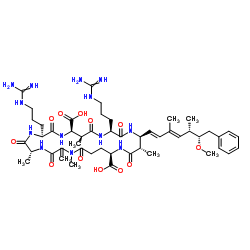Transcriptomic comparison of cyanotoxin variants in a human intestinal model revealed major differences in oxidative stress response: Effects of MC-RR and MC-LR on Caco-2 cells
Perrine Zeller, Hélène Quenault, Antoine Huguet, Yannick Blanchard, Valérie Fessard, Perrine Zeller, Hélène Quenault, Antoine Huguet, Yannick Blanchard, Valérie Fessard, Perrine Zeller, Hélène Quenault, Antoine Huguet, Yannick Blanchard, Valérie Fessard
Index: Ecotoxicol. Environ. Saf. 82 , 13-21, (2012)
Full Text: HTML
Abstract
Microcystins (MCs) are cyclic hepatotoxins produced by various species of cyanobacteria. Their structure includes two variable amino acids (AA) giving rise to more than 90 MC variants, however most of the studies to date have focused on the most toxic variant: microcystin LR (MC-LR). Ingestion is the major route of human exposure to MCs and several in vivo studies have demonstrated macroscopic effects on the gastro-intestinal tract. However, little information exists concerning the pathways affected by MC variants on intestinal cells. In the current study, we have investigated the effects of MC-RR and MC-LR on the human intestinal cell line Caco-2 using a non-selective method and compared their response at the pangenomic scale. The cells were incubated for 4h or 24h with a range of non-toxic concentrations of MC-RR or MC-LR. Minimal effects were observed after short term exposures (4h) to either MC variant. In contrast, dose dependent modulations of gene transcription levels were observed with MC-RR and MC-LR after 24h. The transcriptomic profiles induced by MC-RR were quite similar to those induced by MC-LR, suggestive of a largely common mechanism of toxicity. However, changes in total gene expression were more pronounced following exposure to MC-LR compared to MC-RR, as revealed by functional annotation. MC-LR affected two principal pathways, the oxidative stress response and cell cycle regulation, which did not elicit significant alteration following MC-RR exposure. This work is the first comparative description of the effects of MC-LR and MC-RR in a human intestinal cell model at the pangenomic scale. It has allowed us to propose differences in the mechanism of toxicity for MC-RR and MC-LR. These results illustrate that taking into account the toxicity of MC variants remains a key point for risk assessment.
Related Compounds
| Structure | Name/CAS No. | Molecular Formula | Articles |
|---|---|---|---|
 |
Microcystin RR
CAS:111755-37-4 |
C49H75N13O12 |
|
The conjugation of microcystin-RR by human recombinant GSTs ...
2013-06-07 [Toxicol. Lett. 219(3) , 231-8, (2013)] |
|
Similar uptake profiles of microcystin-LR and -RR in an in v...
2011-11-28 [Toxicology 290(1) , 7-13, (2011)] |
|
In vitro and in vivo safety assessment of edible blue-green ...
2011-07-01 [Food Chem. Toxicol. 49(7) , 1560-4, (2011)] |
|
Antioxidant response in liver of the phytoplanktivorous bigh...
2010-06-01 [Fish Physiol. Biochem. 36(2) , 165-72, (2010)] |
|
Removal of a potent cyanobacterial hepatotoxin by peat.
2010-12-01 [J. Environ. Sci. Health. A. Tox. Hazard. Subst. Environ. Eng. 45(14) , 1877-84, (2010)] |